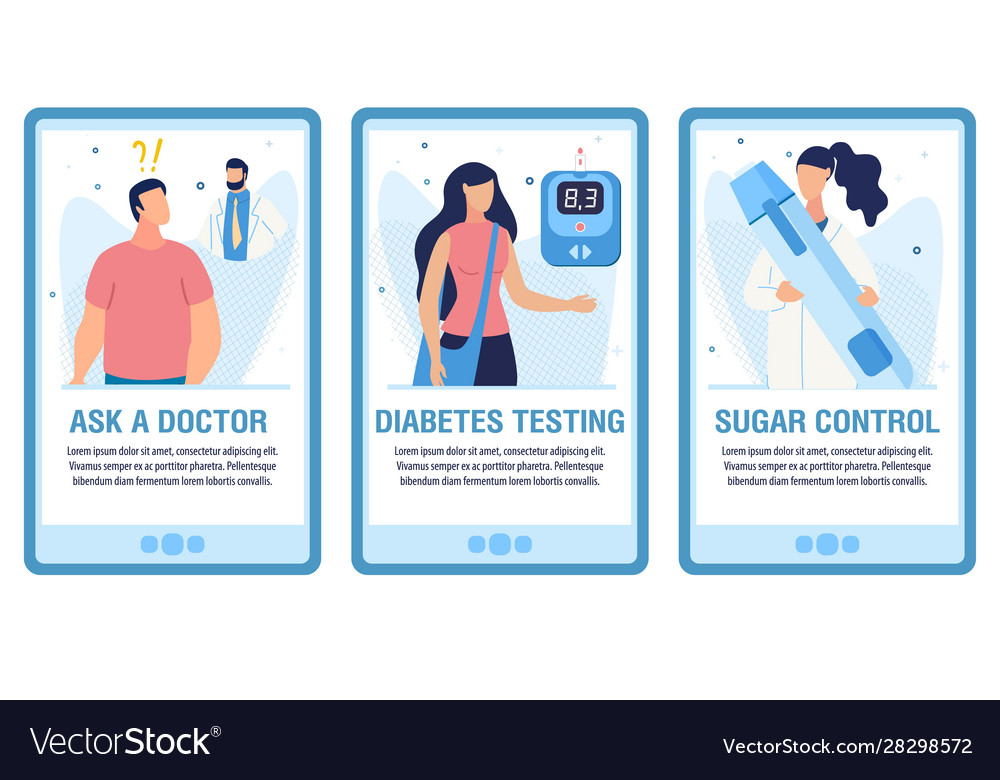What Are The Considerations For Blood Glucose Monitoring?
Houston Endocrine Center2022-09-28T14:36:26+00:00It is known that any diabetic patient should monitor their blood glucose level. Markedly, for people who suffer from type 1 diabetes, measuring their blood glucose is not only one of the vital roles in controlling their disease but also a significant responsibility in living a healthy life as well.
A blood glucose level test is an essential aspect of care for most people with diabetes. While they give you important information, what are the considerations when you are doing one?

Source: VectorStock
You’ve got questions. We’ve got answers. That’s what our health blog is all about. In this blog, we’ll answer the most common question parents ask us: “What considerations should I take into account for blood glucose monitoring of my child?”
There are various factors to consider when you are monitoring blood glucose levels. Many people don’t realize how many things influence the reading they get, including where they put it and which strip they use. So let us get started!
Diabetes

Source: VectorStock
It is a chronic disease in which the pancreas can not produce the right quantity of insulin, or the body fails to make efficient use of it. This makes it difficult for the body to process blood sugar. It may lead to high levels of blood sugar that can damage the other organs of the body.
Multiple factors can cause diabetes. Other than genes, your lifestyle can cause metabolic disorders. Eating unhealthy, being overweight, and living a sedentary life can increase your chances of having diabetes.
Blood Glucose Monitors
Blood glucose monitors are medical devices that measure blood glucose levels. They are used to diagnose and monitor diabetes, as well as for other purposes.
The first blood glucose monitor was invented in 1906 by Sir Frederick Banting and James Collip, who was awarded the Nobel Prize in 1923 for their work. The first commercially available blood glucose monitor was released in 1978 by Roche Diagnostics.

Source: VectorStock
Blood glucose monitors have changed over time as technology has advanced. The earliest form of a blood glucose monitor was a glass tube filled with sugar inserted into the body. The sugar level in fluid changed depending on how much blood flowed through it. These devices had their issues, including the fear that they could cause serious injuries by introducing bacteria or potentially lethal amounts of sugar into patients’ systems. As a result of these concerns, other methods were invented.
The blood glucose monitor measures blood sugar concentration using a small sample of whole capillary blood. It typically uses an enzymatic reaction to measure the sample’s sugar (glucose) concentration and provide an output that shows either a numerical value or a graph on an LCD screen.
This output can help manage diabetes, identify patterns indicating pre-diabetes or diabetes, or test patients for diabetes. These meters are cheaper than most continuous monitoring systems but require frequent re-testing (every 5 minutes).
Blood Glucose Monitoring

Source: VectorStock
Blood glucose monitoring is an essential part of diabetes management. There are a variety of reasons why you might want to monitor your blood sugar levels, including:
- To keep track of your daily blood sugar levels. You can use this information to adjust your treatment plan and make sure that your medication is working properly.
- To make sure that you are staying within the acceptable ranges for your treatment plan. If you don’t stay within these ranges, it may mean that you need to make some adjustments to your treatment plan.
- To check for signs of complications from diabetes, such as high blood pressure or heart disease.
The Main Considerations For Blood Glucose Monitoring
The goal of blood glucose monitoring is to find out what your fasting blood sugar level is before you eat. The number tells you how much glucose (sugar) is in your blood at that moment. Your doctor may also want to see how much glucose is in your blood after you have eaten.
You can get this information from a home blood glucose meter or from a nurse at the health center or doctor’s office. If you have type 1 diabetes, it’s important to test your own blood sugar because there are many things that can affect the number:
1. Your Weight

Source: VectorStock
Your weight can affect the accuracy of your blood glucose readings. If you weigh more than usual, then this may result in higher than usual readings. The opposite is also true – if you weigh less than usual, then this may result in lower than usual readings.
This is because fat cells in your body store large amounts of sugar, which can be released into the bloodstream when you are not eating enough food or exercising regularly. This can cause a sudden drop in blood sugar levels which can cause hypoglycemia (low blood sugar).
*Whether you are a diabetic or not, knowing your body weight is very important. It can tell you if your weight is within the healthy range or not. If it is not, then you will have to take some steps to bring it back to normal. To do this, you need to make sure that you are aware of your current weight and also the ideal weight for you.
2. How Much Exercise You Had

Source: VectorStock
It is important to consider the amount of exercise that you do when monitoring your blood glucose level. This is because exercise can affect the way your body processes insulin and glucose, which could cause your blood sugar to become too high or too low.
If you have diabetes and are considering starting an exercise program, it’s important for you to talk with your doctor about what type of exercise would be best for you. If you have any questions about exercising with diabetes, ask your doctor or a certified diabetes educator (CDE).
The following guidelines may help:
- Before starting an exercise program, check with your doctor about how much time should pass after taking medication before exercising. Your doctor may also recommend having a snack before exercising if you take insulin or other medications that may affect blood sugar levels during exercise.
- If you take insulin or other medications that are used to treat diabetes and want to start exercising, ask your doctor how much time should pass between taking these medications and exercising.
- If possible, don’t exercise on an empty stomach or right after eating because this could cause an increase in blood glucose levels during or after activity.
3. Your Stress Level

Source: VectorStock
You may have heard it before: stress is bad for your health. It’s true, but there’s another important aspect to consider.
Stress can affect your blood glucose levels, and the type of stress you experience can make a difference in how it affects your blood glucose levels.
If you are experiencing high-stress levels, it may be difficult to get an accurate reading from your blood glucose monitor. This is because stress causes blood glucose levels to rise in several ways:
- Stress hormones such as cortisol affect insulin levels, making the body less able to use insulin effectively. This means that more insulin may be needed to control blood glucose levels at a given time.
- Stress hormones may also increase the amount of glucose released from the liver into the bloodstream (hyperglycemia). This can happen even if someone does not have diabetes or another condition associated with increased blood glucose levels (hyperglycemia).
The effect of stress on blood glucose depends on how often the person experiences stress, how intense the stress is, and how long the person experiences the stressful situation.
4. What Time Of Day It Is

Source: VectorStock
The time of the day can have a significant effect on your blood glucose readings. This is particularly true if you are taking insulin or other medications that lower your blood sugar.
The best way to avoid errors in your readings is by considering the time of day when you do your blood glucose monitoring. Here are some things to consider:
- Measure your blood sugar at the same time each day. This will help you get a good idea of how your body reacts to different foods, stressors, and medications.
- Eat a small meal two hours before testing so that your blood sugar levels are more consistent. The best time for blood glucose monitoring is before breakfast because it gives a benchmark for comparison with other readings throughout the day and night. The next best time is after a meal and before bedtime.
- Do not drink alcohol before measuring your blood sugar level unless it’s been at least two hours since you last ate or drank anything other than water.
5. Taking Insulin Or Other Medications

Source: VectorStock
If you were diagnosed with diabetes and are taking insulin, you may be wondering if it’s time to stop monitoring your blood glucose.
The answer is: It depends on several factors.
- If you’re on a maintenance dose of insulin or other medications that control your blood sugar, there are no reasons to stop monitoring your blood glucose levels. You should continue testing as directed by your doctor, especially if you have any symptoms, such as feeling extremely thirsty or having blurry vision.
- You should also continue monitoring if you have type 2 diabetes and are trying to lose weight or control your blood sugar with diet and exercise. If your doctor recommends it, you may need to adjust the amount of medication in order to reach the target range. It’s important that you regularly test so that adjustments can be made before your next appointment.
- If you’re on insulin or another medication that causes low blood sugar, you may be able to skip the finger-prick test after meals if your mealtime blood sugar is within a certain range (such as 100 mg/dL to 140 mg/dL).
Conclusion & Takeaway
Glucose is an important energy source for most life forms. It is a simple sugar, and it is primarily derived from carbohydrates and starches such as fruits, vegetables, bread, and grains.
To ensure that the patient stays healthy, it is essential to monitor the blood sugar randomly. This will help to make sure that you maintain your sugar levels as well as reduce the risk of leg and eye complications.

Source: VectorStock
When heading out to purchase a glucose meter, one will want to consider certain aspects before choosing a specific test kit. Availability and convenience of the test strips are important, as well as ease of use of the meter. What features do I need on the meter, and how much is it going to cost? All of these questions can help narrow down the best choice for monitoring blood sugars.
You can also book an appointment with us for a detailed session about diabetes and blood glucose monitoring. Learn about the basic considerations so that you can look after yourself more carefully.
